Since 1977 love for the Olive


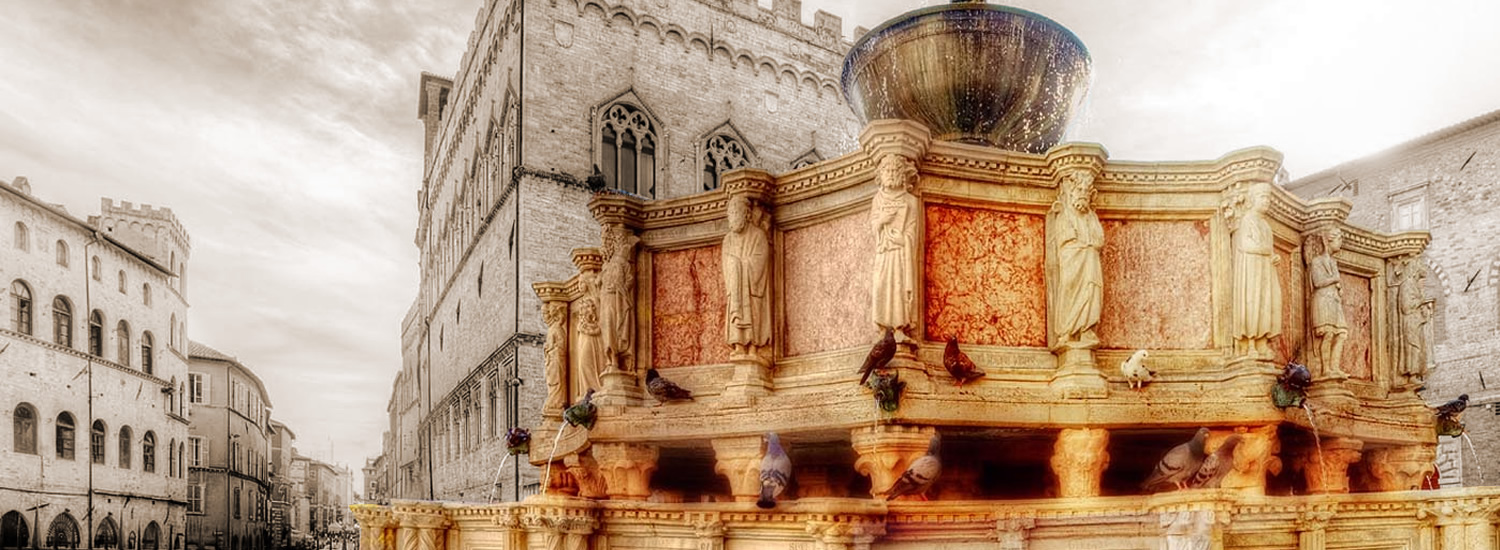
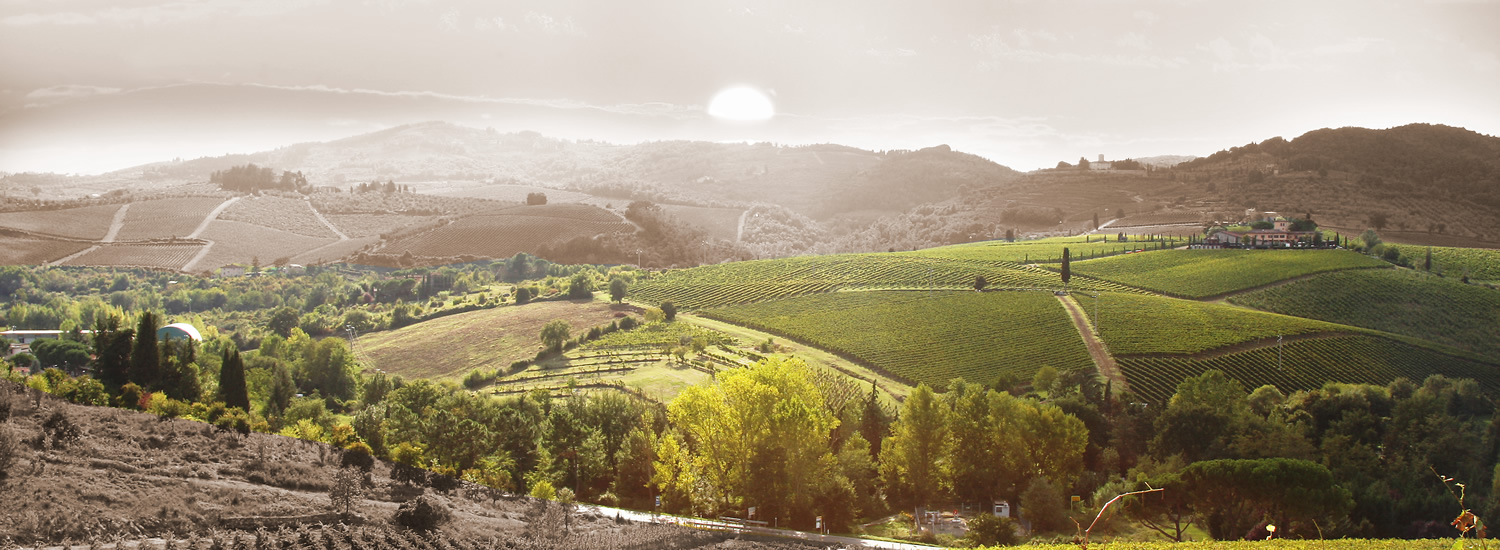
Umbria is just one hour by car or train from Rome or Florence: a region in Central Italy defined as the "Green Heart of Italy" for its geographic location and environmental characteristics. It is not a coastal region yet it has a lot of water. Nature and parks, cities rich in art and culture, open-air sports, international events and excellent food will make your stay truly unforgettable.
Umbria is a land of balance, its myriad facets and souls merging in a single fresco - man and nature, deep spirituality and secular pride. Each place has its own unmistakeable identity, the result of millennia of civilisations that left behind thick layers of memories and timeless masterpieces: Umbrians, Etruscans, Sabines and Romans, followed by the great Medieval and Renaissance eras. Farmers patiently sculpted the landscape by reclaiming land, ploughing and planting olive groves and vineyards, which in addition to producing fine oils and wines, have become the symbol of this territory.
Dotted with medieval hamlets and quiet hermitages, the Umbrian hills are enchanting. A few kilometres are enough to find yourself immersed in nature, with centuries-old beech woods, deep caves and mountains steeped in ancient legends. Water emerges in springs and mountain lakes; it flows in rivers, carving out striking stone canyons; it gathers in swamps and artificial basins, transforming them into natural oases. Lake Trasimeno, the slow flowing Tiber and the drop of the Marmore waterfalls; almost as if they were created deliberately to inspire poets and painters. At the end of the trip, one thing is certain - Umbria is truly beautiful
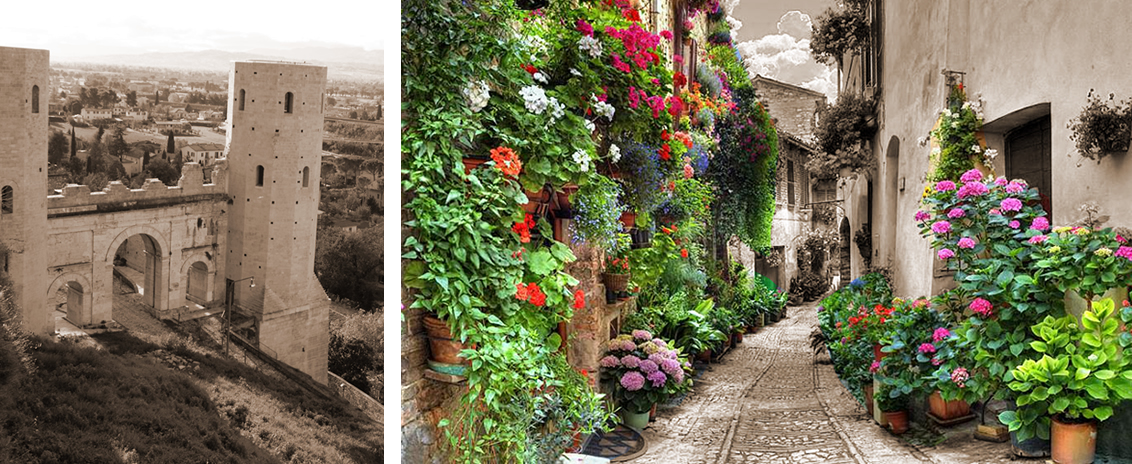
Spello combines its medieval aspect of winding streets and ancient stone houses with numerous Roman remains: such as the town walls used as the base for the medieval walls; the remains of a theatre, an amphitheatre, public baths; and the so-called Arco Augusto, ancient town entry gate. The historical town centre is still encircled by walls erected in 1360 taking in part of the Roman walls and three splendid gates: Porta Consolare (1st century BC), Porta Urbica and Porta Venere from the Augustan era, constructed with a triumphant arch, and on either side the 12-sided towers of Properzio. Some of the most remarkable religious buildings are the church of Santa Maria Maggiore (12th – 13th century), with great art works inside: to the left of the nave is the splendid Cappella Baglioni frescoed by Pintoricchio, as well as paintings by Perugino there is an ancient majolica flooring from Deruta (1516). Pintoricchio also executed the large panel of the Madonna e Santi (1508) in the 13th-century church of Sant'Andrea, which also contains the Crocifisso by the school of Giotto, and the body of Blessed Andrea Caccioli, companion of Saint Francis. Apart from the Palazzo Comunale (Palazzo Cruciani), town hall housing the library, Historical Archives and Accademy of Costantinian Studies; also worthy of a visit are the Palazzo Baglioni (1358), Palazzo dei Canonici, home to the Pinacoteca, art gallery; and the church of San Lorenzo (12th century), where there is a precious marble tabernacle sculpted by Flaminio Vacca (1587). In the vicinity is the interesting church of San Claudio a beautiful example of Romanesque architecture; the church of San Girolamo and attached convent, built in 1472 with money supplied by Braccio II Baglioni, Lord of Spello; Villa Fidelia (16th century), built on the site of the Venus temple, theatre and spa, nowadays displays an interesting collection of paintings, sculptures and antiques. The San Girolamo group of buildings are located in the most striking part of the territory: the area backing onto Mount Subasio, where over the years the vegetation has grown naturally according to the shape of the mountain, developing and blending in with the environmental features of this nature spot.

In the year 2000, Assisi, together with its historic center, the Basilica of St. Francis and other Franciscan sites, and almost the entire municipal territory, was declared part of the World Heritage of Mankind by UNESCO. Among the many monuments that make Assisi one of the Italian tourist destinations most richly endowed with art are the Basilica of St. Francis, a cornerstone of world religious devotion, the Basilica of Santa Chiara, and the Romanesque Cathedral of San Rufino. Standing on the main square are the Palazzo dei Priori, the 13th-century Palazzo del Capitano del Popolo with its Civic Tower, and the Temple of Minerva, a perfectly preserved Roman temple from the late Republican age (1st century BC). Just outside the walls and dominating over the town is the superb Rocca Maggiore, a fortress built in 1367 by Cardinal Albornoz on top of an older structure (1174) from a feudal castle. There are places connected with the life of St. Francis that can be visited in the immediate vicinity of Assisi, such as the Carceri Hermitage, set in a thick wood on the slopes of Mt. Subasio, the Convent of San Damiano, the imposing Basilica of Santa Maria degli Angeli, built between 1569 and 1679 to protect the Porziuncola, the tiny church that welcomed the first community of Franciscans, and the Chapel of the Transito, where St. Francis died on 4 October 1226. For nature lovers, there is the beautiful Mt. Subasio Regional Park, established to protect an area of great environmental value and permeated with a mystical atmosphere.
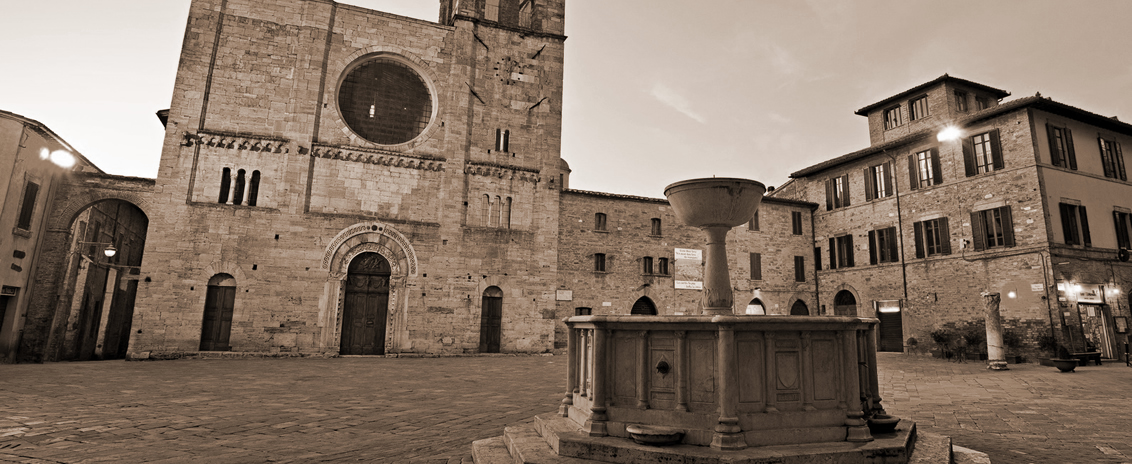
The town, whose medieval (XII-XIII century) urban layout remains intact, is surrounded by walls with towers and gates. The most conspicuous Roman remains are those of a temple, which was then transformed into what was once the Church of the Madonna della Neve, a thermal springs building, which still boasts a II century BCE mosaic floor of white and black tiles depicting marine motifs, and, in the upper part of the town, an area where houses set in a semicircle trace the old theatre (two grooved marble columns now reside in the post office).
The old layout of the Roman city became medieval with piazzas and noble palazzos: on Piazza Silvestri is the Palazzo dei Consoli (1270), which hosts the Teatro Francesco Torti, the Romanesque churches of San Silvestro and San Michele Arcangelo, both constructed in the XII century, and the Church of Santi Domenico e Giacomo (XIV century). A fine example of residential architecture is provided by Palazzo Lepri, on Corso Matteotti, today the home of the city's administration. Inside the palazzo are the Library, the Historical Archives and the City Museum, of which one is devoted to archaeology and the other a picture gallery.
Also worthy of note is the Baroque church of the monastery of Santa Margherita and the church of San Filippo (1725). The Church of San Francesco (fine XIII century) is located at the town's highest point. Next to the altar is the stone on which St. Francis leaned as he preached to the birds at Pian d'Arca.
Outside of town, on the surrounding hilltops, are the Sanctuary of Madonna delle Grazie (late XVI century), the Sanctuary of Madonna della Valle and the Convent of the Annunziata (XI century), once a castle constructed to defend the area.
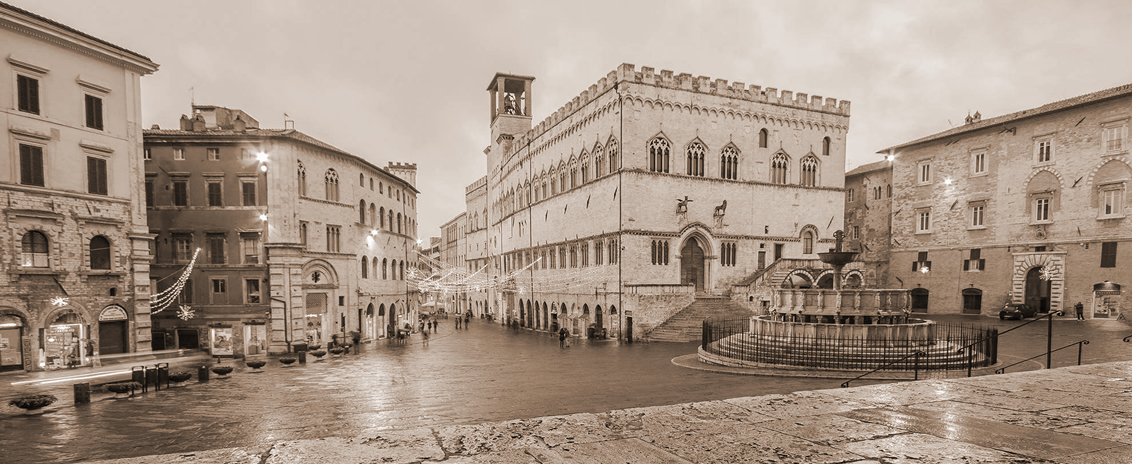
Perugia has an immense heritage of art and culture, the fruit of its glorious past. One finds monuments everywhere bearing witness to its many centuries of history, art and culture, from its squares to its tiniest alleys, starting with the Etruscan Arch, also known as the Arch of Augustus, a monumental gate in the ancient Etruscan city walls and later restored in Roman times, the Etruscan Well and Porta Marzia, the second monumental Etruscan gate, now incorporated in a rampart of the Rocca Paolina, a fortress erected by Pope Paul III in 1540. Standing on Piazza IV Novembre, one of the most beautiful squares in Italy, is the Palazzo dei Priori. An elegant Gothic edifice, it is also the home of the National Gallery of Umbria, which holds some of the greatest masterpieces of Italian art from the Middle Ages to the 18th century, including works by Piero della Francesca, Benozzo Gozzoli, Beato Angelico, Pinturicchio, and Perugino. Also very fine are the Sala dei Notari, the Collegio del Cambio, the old seat of the money exchangers' guild, with the famous fresco cycle by Perugino and the San Giovanni Battista chapel with 16th-century frescoes, the Collegio della Mercanzia, the Cathedral of San Lorenzo and its annexed Chapter Museum, and the gorgeous Fontana Maggiore, a 13th-century fountain designed by Frà Bevignate of Perugia with bas-reliefs by Nicola and Giovanni Pisano. Other interesting buildings are the Palazzo del Capitano del Popolo and the Palazzo della Vecchia Università, the old seat of the university and now used as the Perugia Courthouse, Palazzo Donini and Palazzo Cesaroni, respectively the seats of the Umbria Regional Cabinet and the Regional Council, the Palazzo della Provincia (1870) in the Lombard style, and Palazzo della Penna, an exhibition center with permanent collections and which also hosts temporary exhibits. There is also the elegant theater, Teatro Morlacchi (1788), as well as Palazzo Antinori-Gallenga Stuart (1754), home of the University of Foreigners. Perugia has many religious buildings worthy of note: the Basilica of San Pietro, with its splendid cloister, the Basilica of San Domenico, next door to the National Archeological Museum of Umbria and its extensive collection of Umbrian, Etruscan and Roman artifacts, the round Temple of Sant'Angelo, the San Francesco al Prato complex with the former church of San Francesco and the Oratory of San Bernardino, the Church of San Filippo Neri, the San Severo Chapel with a fresco, the Holy Trinity and Saints, painted in part by Raphael and in part by Perugino, the Church of Santa Maria Nuova with a wooden choir and organ built in 1584, the Church of Sant'Ercolano, and the Church of San Bevignate (13th century). Other enjoyable visits in town are the Botanical Garden and the Medieval Garden, the latter at the Abbey of San Pietro; places of interest in the nearby area include the Volumni Hypogeum (2nd cent. BC) in Ponte San Giovanni and Perugino's tomb and frescoes by him in Fontignano.
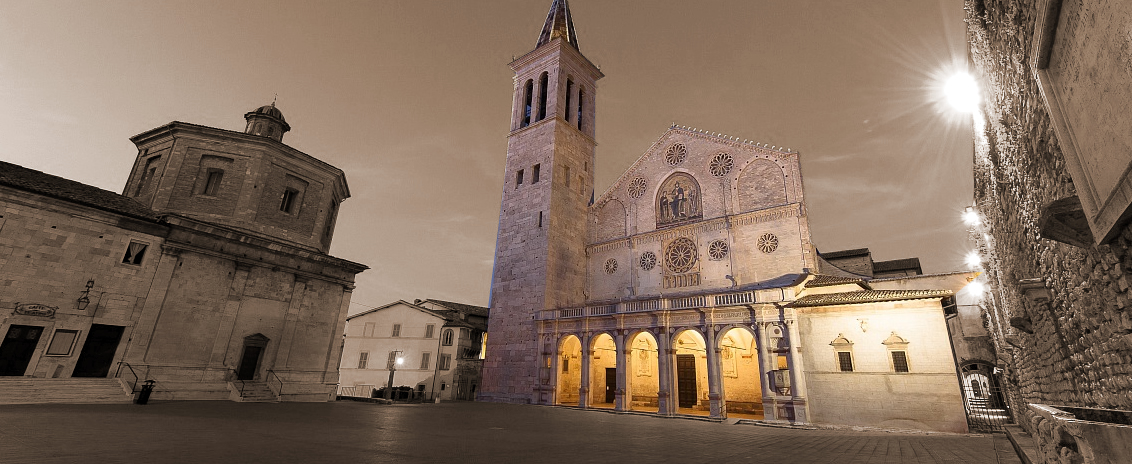
The historic center has maintained its medieval appearance, although traces of its Roman heritage are still visible. Spoleto's most ancient monuments are the Arch of Drusus and Germanicus, a Roman arch that led into the forum (now Piazza del Mercato), near the Romanesque Church of Sant'Ansano, the Roman theater, and the Basilica of San Salvatore, an interesting early Christian monument that goes back to the 4th-5th century. Not far away from the 13th-century Church of San Gregorio Maggiore, characterized by its suggestive apse area and the raised presbytery, are the triple-spanned Roman Bridge (or Ponte Sanguinario) made from blocks of travertine and the Amphitheater from the 2nd century AD. The town's greatest monument is the Duomo (Cathedral). Built in the Romanesque style in the 12th century, it was subsequently modified with the addition of a Renaissance portico to the façade, which is decorated with a large Byzantine-style mosaic (1207). Inside are many excellent works of art, including a fresco of the Madonna and Saints by Pinturicchio, the bronze bust of Urban VIII by Bernini, and an extraordinary fresco cycle by Filippo Lippi. The 12th-century Church of Sant'Eufemia is an interesting Romanesque building whose apse faces the stairs leading to Piazza Duomo, the Church of SS. Giovanni e Paolo and the Church of San Ponziano. The Churches of San Domenico and San Nicolò and the Palazzo Comunale, or Town Hall, are instead from the 13th century. The Municipal Picture Gallery holds important works, including a Crucifix on canvas by an Umbrian artist (12th century), two frescoes by Spagna and a Mary Magdalene attributed to Guercino. Also of interest are the Church of San Paolo Inter Vineas (10th century), with an important cycle of 13th-century frescoes, and the Church of San Pietro, built in the 5th century, which has a splendid sculptured Romanesque façade decorated with exceptionally fine bas-reliefs. There are beautiful, wide-open views of all of Spoleto from the area in front of San Pietro, taking in also the mighty Ponte delle Torri, a bridge 80 meters high and 230 meters long supported by ten pointed arches. An ancient Roman aqueduct rebuilt in the 1300s, it links the Rocca Albornoziana, a fortress Cardinal Egidio Albornoz had built starting in 1352 to a design by Matteo Gattaponi, to the slopes of the mountain, Monteluco, overlooking the town. This area of pristine nature has a wood considered sacred by the anchorites who settled here starting in the 7th century and later founded the Convent of San Francesco (1218) and the Church of San Giuliano. Returning to the town proper, deserving of a visit are the Palazzo Collicola, which houses the Municipal Modern Art Gallery, the Archbishop's Palace (Diocesan Museum), Palazzo Racani-Arroni, seat of the Italian Center for Early Medieval Studies, the Teatro Nuovo (1854-64) built on the site of the ancient Roman baths, the Teatro Caio Melisso (1877-1880), the Archeological Museum in the former convent of Sant'Agata, the Diocesan Museum and the Roman house, built in the 1st century AD. Near Spoleto, the "sacred wood" of Monteluco, densely grown with evergreen ilexes, is a beautiful natural and spiritual area. The noteworthy Villa Redenta is built over the remains of a Roman villa, with a beautiful park filled with ancient trees – cedars of Lebanon, ilexes and magnolias – among which the Spoleto nobles strolled in the 17th-19th centuries.
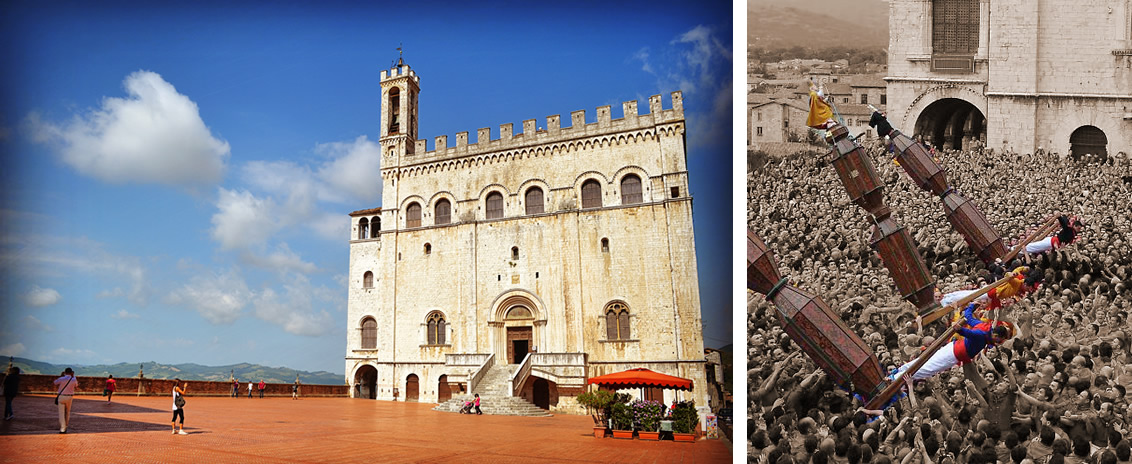
Gubbio is one of the most ancient towns in Umbria, remaining marvelously well-preserved over the centuries, with many monuments that bear witness to its glorious past. Architecturally it represents the zenith of medieval civilization and of society in the 1200-1300s, with the system of the guilds.
Evidence of its ancient origins is provided by the Eugubine Tablets, one of the most important archeological records in Italy – seven bronze tablets with writing in the Umbrian language preserved at the Civic Museum – and the Roman Theater standing just outside the city walls. The monumental Basilica of Sant'Ubaldo, which holds the remains of the town's patron saint, towers over Gubbio, with its architectural masterpieces that stand as symbols of the power of this medieval city-state.
Construction began in the early 14th century on the superb complex that includes the Palazzo dei Consoli, symbol of the town and home of the Picture Gallery and Archeological Museum, the Piazza della Signoria and Palazzo Pretorio, which serves today as the Town Hall. Also deserving mention are Palazzo Beni, the Bargello with its famous fountain, and the Palazzo del Capitano del Popolo. The Renaissance Ducal Palace, attributed to Francesco Giorgio Martini, documents the town's brilliant period under the rule of the Montefeltro dukes. Also interesting are the Cathedral (12th century), Santa Maria Nuova, with the Madonna of the Belvedere by Ottaviano Nelli inside, the Church and Convent of Sant'Agostino (13th century) with frescoes by Nelli, the Church and Convent of San Francesco, San Giovanni, characterized by the Romanesque façade and bell tower, San Pietro and San Domenico. Also of interest are Piazza 40 Martiri with the Church and Ospedale dei Bianchi, the Loggia dei Tiratori and the Church of Sant'Andrea or Monastery of di San Marziale.
Sights outside the walls are the Roman Mausoleum, the Church of San Secondo, the Church of Madonna del Prato and the Church of the Vittorina.
Natural attractions include the Mt. Cucco Park nature area and the fascinating Bottaccione Gorge, with the rocks that, according to one theory, reveal the secrets of the disappearance of the dinosaur 65 million years ago.
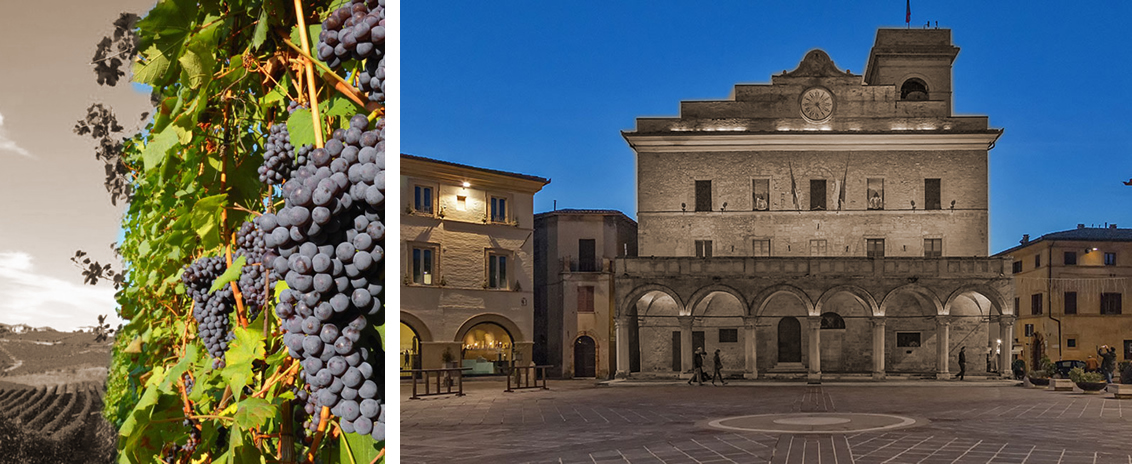
Montefalco encloses an important heritage of art that makes it an essential point of reference to understand Umbrian painting, starting from the church museum of San Francesco, constructed for the Minor Friars between 1335 and 1338. The museum is laid out in three exhibition spaces: the ex-church, known the world over for the fresco cycle painted by Benozzo Gozzoli between 1450 and 1452 that depicts the Life of Saint Francis, and where there is also displayed a Natività by Perugino (early 16th century), and frescoes by the Umbrian school; the Art Gallery with works by Francesco Melanzio, Antoniazzo Romano and the Umbrian school from the 1300s to 1700s; and the crypt with archaeological findings, sculptures and pieces from various eras. Cinta Duecentesca, thirteenth-century walls, is the name given to the compact city-walls restored in the 14th century by Lorenzo Maitani, which are still today in good order. The medieval layout of the town is dominated by the church of Sant'Agostino, featuring frescoes by Ambrogio Lorenzetti and Bartolomeo Caporali, built at the same time as the convent in the second half of the 13th century above a small building dedicated to St John the Baptist. The main square of the town, Piazza del Comune, offers a concentration of aristocratic palaces such as the 14th century Palazzo Pambuffetti, Palazzo Senili and Palazzo Santi-Gentili (15th century), Palazzo Langeli and Palazzo De Cuppis o Camilli (16th century). The Town Hall, Palazzo Comunale, was constructed in 1270, then embellished with a loggia, and in the 18th century the bell tower, Torre Campanaria, was added and topped with a fastigium to modify the facade. Across the square is the small church of S. Maria de Platea one of the oldest buildings in town, used to hold the first public meetings of the commune. Also worthy of a visit is the Romanesque church of San Bartolomeo; the nearby gate, Porta di Federico II, from 1244; and the church and convent of Santa Chiara with 14th century paintings by the Umbrian school. In the vicinity stands the church of Santa Illuminata (16th century) with side niches frescoed by Francesco Melandio; and the Convento di San Fortunato (15th century) where the church was frescoed by Benozzo Gozzoli and Tiberio d'Assisi. The Montefalco district, together with the municipalities of Giano dell'Umbria, Gualdo Cattaneo, Bevagna and Castel Ritaldi, are part of the food and wine itinerary of the Sagrantino Wine Route, one of the most prestigious wines produced in Umbria. The historic palace, Santi Gentili, is the headquarters of the Centro Nazionale Vini Passiti, National Sweet Wines Centre, set up by the Municipal Council of Montefalco in 1991.
Credits: www.umbriatourism.it